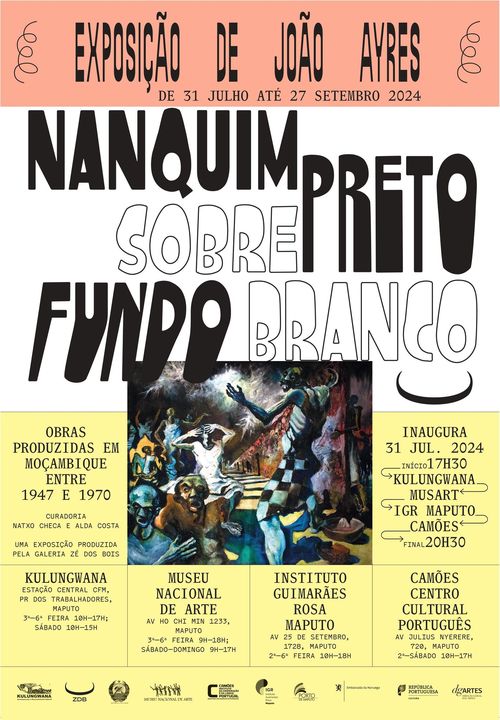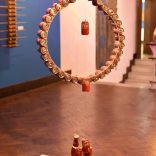‘Strategic Alternatives: A Brief Manual for the Initiated in N’txuva – João ...
‘Black Nankin on a White Background’ – João Ayres exhibition in Maputo

‘Black Nankin on a White Background’ – João Ayres exhibition in Maputo
The Kulungwana Association (Mozambique) and the Zé dos Bois Association (Portugal) present, in partnership with the National Art Museum, the Camões – Portuguese Cultural Centre and the Guimarães Rosa Institute, in Maputo, a solo exhibition by João Ayres (1921-2001) ‘Black Nankin on a White Background’,
The opening of this exhibition took place on Wednesday, July 31, at 5:30 p.m., starting at the Kulungwana Gallery, and continuing at the other three cultural spaces involved, namely MUSART, the Guimarães Rosa Institute and Camões, where the private viewing closes at 8:30 p.m., offering the public a general tour of this unprecedented joint exhibition on the same evening.
“Black Nankin on a White Background” is curated by Natxo Checa (Portugal) and Alda Costa (Mozambique) and occupies the four partner spaces simultaneously. It comprises a large group of paintings and drawings produced by João Ayres between 1947 and 1970 in Maputo.
The exhibition presents and proposes a look at the first three decades of João Ayres’ artistic production, reaffirming his historical and artistic importance as a precursor of Modernism in Mozambique. It is a return to the mother country, to the territory where the works were produced, works whose character presents points of convergence with the intercontinental currents prevailing at the time (South Africa, Brazil, Portugal, Mozambique, among others).
After decades of being forgotten, both in Mozambique and in Portugal, and after a successful first exhibition in Lisbon (2022/2023), at Galeria Zé dos Bois, where paintings and drawings were exhibited that covered the artist’s first decade of Mozambican production (1946-1957), the time has come for a broader presentation of João Ayres’ work, which gives the Maputo public, after more than 50 years, the opportunity to come into contact with, enjoy and value his extraordinary work with African roots that encompasses neorealism, concretism and expressionism, sometimes figurative and sometimes abstract.
Across the four spaces of the exhibition can be seen bodies struggling and lamenting the setbacks of the human condition – with emphasis on the paintings of Cais Gorjão in the 1940s;
– a series of neo-expressionist paintings and drawings from the early 1950s, designed to be shown at the Museum of Modern Art in São Paulo, at the invitation of the arts patron Ciccillo Matarazzo, and at the gallery of the Ministry of Education and Culture in Rio de Janeiro, at the invitation of prominent figures in the arts;
– a series of Indian ink drawings from the concretist movement, in which the artist stops representing a condition that is alien to him and moves on to pure abstraction;
– a series of works produced after João Ayres returned from Brazil, in the mid-1950s, until the 1970s, some of them from the collection of the National Museum of Art, which vary between painting on cardboard and Indian ink on paper, in which we recognize figures, bodies, faces, masks, colors and shapes, which undoubtedly refer us to his local Mozambican life.
The complementary programme for this exhibition includes a screening of the film João Ayres, Independent Painter (2022), by Diogo Varela Silva, and guided tours, among other activities.
The exhibition is produced by the Associação Zé dos Bois and the Associação Kulungwana, in partnership with the Museu Nacional de Arte, Camões – Centro Cultural Português and the Instituto Guimarães Rosa, and is supported by the Direção Geral das Artes de Portugal (DGArtes), Sociedade de Desenvolvimento do Porto de Maputo (MPDC) and the Norwegian Embassy in Maputo.
Entrance is free (except for the Museu Nacional de Arte, where current access conditions apply) and the exhibition will be open until 27 September 2024 in all four spaces in Maputo.
João Ayres (1921-2001)
Was born in Lisbon in 1921.
He studied architecture at the School of Fine Arts in Lisbon and Porto. In 1944 he was part of the II salon “Independents” (collective exhibition where, among others, participated Fernando Lanhas, Nadir Afonso and Júlio Rezende) at the Coliseu in Porto, and the annual exhibition of the National Society of Fine Arts in Lisbon.
He moved to Mozambique in 1946, where he began his artistic practice more intensely and where he taught drawing and painting at the Núcleo de Arte in Maputo.
He exhibits for the first time, with his father, the painter Frederico Ayres, in 1947
. In the following years he participated in various collective exhibitions and began to have contacts with Pancho Guedes, Cândido Portinari, Walter Battiss, and various South African and Rhodesian painters. He held his first solo exhibition in 1949, promoted by the Núcleo de Arte, where he exhibited his first neo-realist paintings.
He continued to exhibit collectively and individually in the following years, highlighting the solo exhibitions at the Museum of Modern Art in São Paulo (1955); at Voster’s Gallery in Pretoria (1961); at the Left Bank Galleries in Johannesburg (1965); at the Calouste Gulbenkian Foundation in Lisbon (1981).
João Ayres is represented in various Portuguese and international private and institutional collections, including the Calouste Gulbenkian Foundation, the Museum of Modern Art of São Paulo, the Brazilian National Pinacoteca, and the Grão Vasco Museum in Viseu.
In 2022, Diogo Varela Silva directed the documentary ‘João Ayres, Independent Painter’.




Leave a Reply
Be the First to Comment!
You must be logged in to post a comment.
You must be logged in to post a comment.